When I started reading about the history of the road itself, its construction, what it was used for during its life span and how it was quickly replaced by other highways, I found out that there was actually more to it. As a matter of fact the history of the route overlapped on the United States History on a more general scale. The history of Route 66 paralleled several major historical events; some were even linked to one another as the route played different important roles on different instances along History. Route 66 took on a brand new aspect of the notion of „Lieu de Mémoire‟.
Route 66 can be considered as a „Lieu de Mémoire‟ in two ways. First, because it is a representative and evocative testimony of the History of the United States; some sort of primary source you can run through and on. But it is also a „Lieu de Mémoire‟ for many people who travel on this route, in order to find the remainders of a past time, dear to them. Moreover, we can consider it as a „Lieu de Mémoire‟ still alive because numerous enthusiasts strive to keep Route 66 alive, to protect it and what it represents. Furthermore, it has generated a great deal of commercial nostalgia in the popular imagination and has lead to the creation of considerable Route 66 memorabilia and other diverse products.
The term „Lieu de Mémoire‟ entered the French dictionary Le Grand Robert de la Langue Française in 1993, with the following definition:
Loc. (1984) “Unité significative, d‟ordre matériel ou idéel, dont la volonté des hommes ou le travail du temps a fait un élément symbolique d'une quelconque communauté”
Route 66 matches the definition of the ‘Lieu de Mémoire’ (by Pierre Nora) on two distinct levels: US Highway 66 has a material history as a major US transportation corridor from 1926 to about 1970, during which it played important roles for the whole nation; and a symbolic dimension, as a pillar of mid-twentieth century American culture and tourism.
Pierre Nora defines the „Lieux de Mémoire‟ as the places which have become symbols of the national memory, be it through the process of time or the work of men. But he doesn‟t use the word „lieu‟ to refer to a location strictly speaking; he includes in his definition any item which can take on a symbolic dimension-be it a celebration or holiday, an emblem, a monument, a eulogy, a dictionary, a museum or even a commemoration. That is to say that he encompasses natural or material places with spiritual or intellectual ones. His definition allows him to consider several groups of symbols.

[L]es grandes catégories d‟objets qui relèvent du genre – tout ce qui ressortit au culte des morts, tout ce qui relève du patrimoine, tout ce qui administre la présence du passé dans le présent.
He also explains what the „Lieux de Mémoire‟ consist of, how they come into being and what they represent for the nation. Numerous authors, who wrote about Route 66, have opinions regarding the highway and what it represents, which match the elements Nora points as necessary to the definition of „Lieux de Mémoire‟.
Les lieux de mémoire, ce sont d‟abord des restes.
As a matter of fact, Route 66 doesn‟t exist officially anymore. The highway was decommissioned in 1985 after it had been completely bypassed by interstate highways. The shield signs „U.S. Highway 66‟ were removed and the road disappeared from the official maps. But the route itself still exists because it has not been unpaved. Yet it is not easy to find the road, because there is no official trace of it. Some signs „Historic Route 66‟ have started to be put up along the road to indicate where it passes. Ever since the highway was decommissioned, its maintenance depends only on private funds. Although several state associations campaign to preserve it alive, the highway has not completely survived. Only portions of the route still exist and among those, all are not drivable.

This ambiguous status of Route 66 is a recurrent matter in the literature dedicated to the highway.
Michael Wallis says:
The old road itself can be found in every one of the eight Route 66 states. It‟s still there. And in many places the signs are returning; its proud name had been retained. There remain motor courts, gas stations, curio shops, and tourist attractions operating on the edges of the old highway.
On the same topic, Russell Olsen, who traveled „Historic Route 66‟ in search of the original places that survived on the road, explains in The Complete Route 66 Lost and Found-Ruins and Relics revisited (2008)
Around 1998, when I began collecting postcards of the route, it occurred to me that many of the places depicted on the postcards were either long gone or in danger of becoming lost to fast-food establishments, self-storage businesses, and mini malls. […] I realized that it was important to record as many of these sites as possible before they were lost forever in the name of „progress‟. Future generations that might never have a chance to experience the Mother Road could look back and re-live a Route 66 trip, if only in the pages of a book. […] Several places that I covered in the first Route 66 Lost & Found (2004) have since undergone significant changes. Some were lost.
Route 66 may not exist officially anymore; and it may not be materially complete anymore; but it is striving to survive in an in-between state of decay and perseverance.
Nora says that the „Lieux de Mémoire‟ are :
Lieux rescapés d‟une mémoire que nous n‟habitons plus, mi-officiels et institutionnels, mi-affectifs et sentimentaux ; lieux d‟unanimité sans unanimisme qui n‟expriment plus ni conviction militante ni participation passionnée, mais où palpite encore quelque chose d‟une vie symbolique.
Considering what we have said, it appears clear that Route 66 matches this definition. During its existence as an official road, Route 66 served many purposes and generated various sentiments in people‟s minds. Tom Snyder proudly states thatthere ought to be a saying that you can‟t keep a good road down. You may take away her destination, even steal her magic numbers. But you can‟t keep old Route 66 out of the hearts and thoughts of three generations of road-borne Americans. Just by driving the old road and visiting with the truly wonderful people to be found along the way, you‟ll become part of the spirit and the legacy of Route 66 across America.
Likewise Michael Wallis writes “From Illinois to California a Route 66 revival continues, grows larger, and gains momentum. The Mother Road is stronger than ever. The old road has a new life.”
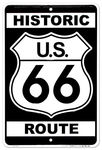
Those accounts underline the fact that although Route 66 is officially dead, it has created some sort of shock wave that still vibrates in the American consciousness, as Peter Dedek explains:
After the highway officially ceased to exist in 1985, a grassroots movement formed to save the memory of a highway that had become too famous to be forgotten. Route 66 became an object of nostalgia fueled by the highway‟s associations with Indians, Mexicans, cowboys, the Okies, deserts, and family vacations.
Nora continues his definition by saying:
Lieux donc, mais lieux mixtes, hybrides et mutants, intimement noués de vie et de mort, de temps et d‟éternité ; dans une spirale du collectif et de l'individuel, du prosaïque et du sacré, de l‟immuable et du mobile. Car s'il est vrai que la raison d'être fondamentale d'un lieu de mémoire est d‟arrêter le temps, de bloquer le travail de l'oubli, de fixer un état des choses, d‟immortaliser la mort, de matérialiser l‟immatériel pour enfermer le maximum de sens dans le minimum de signes, il est clair, et c‟est ce qui les rends passionnants, que les lieux de mémoire ne vivent que de leur aptitude à la métamorphose, dans l‟incessant rebondissement de leurs significations et le buissonnement imprévisible de leurs ramifications.
Several notions he introduces are very relevant when dealing with Route 66 and once again concur with what is expressed in Route 66 literature. Indeed, Route 66 is a survivor, evolving in a state between life and death. Hence it is constantly changing: it has changed over time, it has gained in fame and evolved in various ways in the minds of people. Thus over time and in the evolution of the American consciousness, Route 66 has become something of a myth and numerous images and clichés are now attached to it.
Peter Dedek sums up quite nicely this point.
Virtually every American has heard of “Route 66” or technically “ US Highway 66”, and some have a vague notion, like I did in 1992, that the highway was somehow “western” and a thing of the past, but that‟s about all they usually can say about it. Route 66 is well known but not widely understood. […] They associate the route with a variety of images, ideas, and nostalgic experiences, real or imagined […] Route 66 means different things to different people. To some contemporary enthusiasts, the highway is a symbol and remnant of the „good old days‟ of the 1950‟s, which they believe was a moral and upstanding period of American history. For others, the highway resents the beginning of the freewheeling road culture of individuals such as Jack Kerouac, who helped spawn the cultural changes of the 1960‟s. Others see Route 66 primarily as the road of migration and „flight‟ of the Okies, and later, GIs returning from the Second World War looking for a new life in California. To most Americans, Route 66 represents the quintessential American highway and the route through the Southwest where the Old West lives on.
The previously mentioned Russell Olsen agrees when he states
Someone said that Route 66 meant going somewhere. It did and still does. It also meant change. Change is inevitable, and even an old, beloved historic highway goes through its share. Sometimes it is a quick transformation and other times it is a slow decay.

Finally, another major aspect of the notion of „Lieux de Mémoire‟ can be found in this statement :
des ensembles construits par le temps, et qui tirent leur signification des rapports complexes entre leurs éléments : miroirs du monde ou d‟une époque.13
Before its official closure in 1985, historic US 66 had long been associated with the deserts, Indians, and cowboys of the Southwest, the “Okies” of the Great Depression, and with millions of vacationers who took to the highway in their streamlined automobiles and found adventure on the open road from the late 1940‟s until the 1970‟s. The highway has maintained these associations since it was closed.
On that very important point, most Route 66 authors concur.
Peter Dedek states :
Because of its association with the Southwest and its popularity with Americans, Route 66 provides a unique vantage point from which to better understand American popular culture from the 1920‟s to the present. Route 66 has such notoriety and such rich array of images, concepts and metaphors associated with it that studying its place in American culture reveals a great deal about how Americans view, revere and revile the recent past.[…] The highway also became the focus of a general glorification of the 1950‟s American automobile culture. Route 66 came to represent a host of alluring American concepts such as the Wild West, individualism, innocence, self-realization, patriotism, coming-of-age, and the freedom of the open road. The Route 66 shield has become a popular icon that represents these ideas and America itself.
Russell Olsen reflects on what those associations mean today.
Route 66 connected the fabric of our society with 2400 mile concrete ribbon woven through small towns, cities, mountains, and deserts. When we changed, the road changed. The road and the roadside culture became a reflection of times. Even today, the road continues to evolve, transforming the landscape of our favorite highway, which continues to be a reflection of who we are and a mirror of our times. You may not like the changes, but we are still in that reflection just the same.
And finally, Michael Wallis writes in “Route 66: All American Road”, published in the magazine Route 66 New Mexico:
Remember that the highway-our highway- is a true mirror of the nation. Like all roads, this road and what takes place on this road reflects our society and culture.
Route 66 seems to be a thorough and fascinating topic. Route 66 has a rich history for itself, but it is also directly linked to the History of the United States. The construction of Route 66 favored the evolution of the American nation and engendered some events, while some events helped Route 66 develop. Reflecting on how all this is connected promises to be a thrilling and comprehensive study.
Furthermore, Route 66 is still very present-not necessarily as a material road- in the hearts and minds of quite a lot of people. Route 66 has reached the status of a myth, it represents various things to various kinds of people for whom the old road is a dear element they worship. Understanding how a road could leave such a mark in people‟s mind appears to be an interesting case study. And looking at the different symbolic meanings it has will probably reveal a lot about American society and the American consciousness.


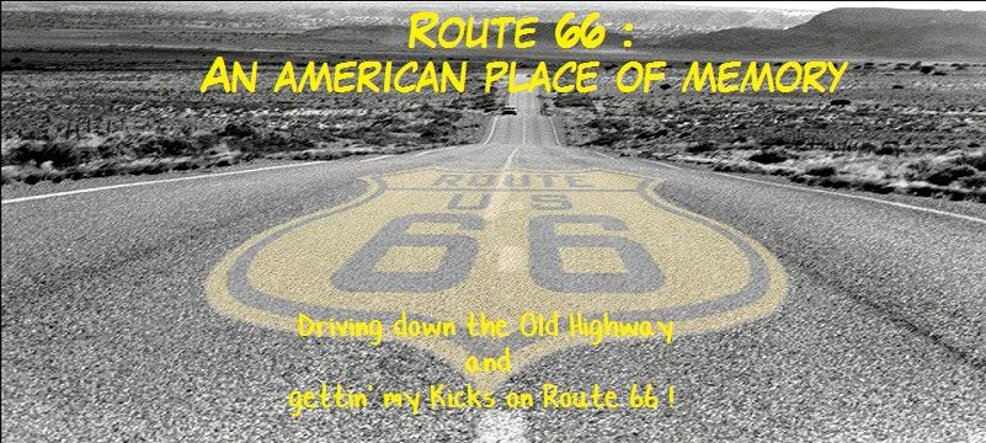
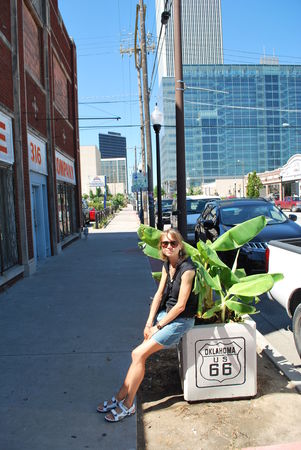



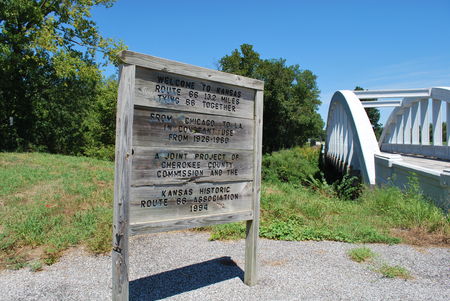








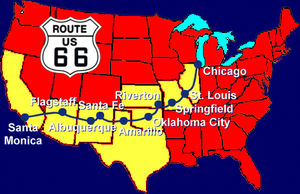





/https%3A%2F%2Fprofilepics.canalblog.com%2Fprofilepics%2F6%2F6%2F662681.jpg)
/https%3A%2F%2Fstorage.canalblog.com%2F60%2F24%2F768556%2F56148714_o.jpg)
/https%3A%2F%2Fstorage.canalblog.com%2F53%2F89%2F768556%2F56033766_o.jpg)
/https%3A%2F%2Fstorage.canalblog.com%2F09%2F88%2F768556%2F55929704_o.jpg)
/https%3A%2F%2Fstorage.canalblog.com%2F04%2F33%2F768556%2F55929573_o.jpg)
/https%3A%2F%2Fstorage.canalblog.com%2F14%2F57%2F768556%2F55896278_o.jpg)